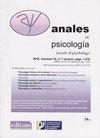Bullying and cyberbullying, what do they have in common and what not? A latent class analysis
IF 1.4
4区 心理学
Q3 PSYCHOLOGY
引用次数: 0
Abstract
Bullying and cyberbullying are risky behaviours which normally occur during adolescence. Although an important relationship has been recognized between the two phenomena, issues related to their prevalence, the similarity and difference between them, the transfer of roles, as well as the emotional, social, and moral aspects associated with them, remain unresolved. The aim of this study was to explore the roles of involvement in bullying and cyberbullying through an analysis of latent classes, and examine their association with moral disengagement, social and normative adjustment, and anger rumination. The study had a two-stage longitudinal design, with 3,006 secondary school students (Mage = 13.53; 51.9% girls), using extensively validated self-reports in the reference population. The results showed four latent classes: uninvolved, victim-cybervictim, bully-victim and wholly involved. Logistic regression analyses identified a low social adjustment in those wholly involved, low normative adjustment and high moral disengagement in mixed profiles, and high anger rumination in all involvement profiles, mainly in bully-victim. These results are discussed in terms of their value in understanding the distinctions between bullying and cyberbullying, the existence of pure and mixed roles, and the associated emotional, social, and moral variables. El acoso escolar y el ciberacoso se presentan como comportamientos de riesgo durante la adolescencia. Aunque se ha reconocido una importante relación entre ambos fenómenos, aspectos referidos a su prevalencia, la semejanza y diferencia entre uno y otro, la transferencia de roles, así como los aspectos emocionales, sociales y morales asociados aún están sin resolver. El objetivo fue explorar los perfiles de implicación en acoso y ciberacoso a través de un análisis de clases latentes y examinar su asociación con desconexión moral, ajuste social y normativo y rumiación de la ira. Se presenta un estudio longitudinal en dos tiempos con 3,006 escolares de secundaria (Medad = 13.53; 51.9% chicas). Se utilizaron autoinformes ampliamente validados en la población de referencia. Los resultados mostraron cuatro clases latentes: no implicados, víctimas-cibervíctimas, agresores victimizados y totalmente implicados. Análisis de regresión logística identificaron un bajo ajuste social en los totalmente implicados, bajo ajuste normativo y alta desconexión moral en perfiles mixtos, y alta rumiación de la ira en todos los perfiles de implicación, principalmente en agresores victimizados. Se discuten estos resultados en términos de su valor para comprender los matices que distinguen el acoso y ciberacoso, de la existencia de roles puros y mixtos y de las variables emocionales, sociales y morales asociadas.欺凌和网络欺凌,它们有什么共同点?潜在阶级分析
欺凌和网络欺凌是通常发生在青春期的危险行为。虽然这两种现象之间已经认识到了重要的关系,但与它们的普遍性、它们之间的相似性和差异、角色的转移以及与它们有关的情感、社会和道德方面有关的问题仍未解决。这项研究的目的是通过对潜在阶级的分析,探讨参与欺凌和网络欺凌的作用,并审查它们与道德失范、社会和规范调整以及愤怒反思的联系。这项研究有一个两阶段的纵向设计,有3006名中学生(MAGE=13.53;51.9%的女孩),在参考人群中使用了广泛验证的自我报告。结果显示,有四个潜在的类别:未成年人、受害者-Cybervictim、欺凌受害者和完全参与。后勤回归分析发现,所有参与方的社会调整水平较低,规范性调整水平较低,混合模式中的道德设计较高,所有参与模式中的愤怒反刍程度都很高,主要是在欺凌受害者中。这些结果是从它们在理解欺凌和网络欺凌之间的区别、纯粹和混合角色的存在以及相关的情感、社会和道德变量方面的价值来讨论的。学校欺凌和网络欺凌是青春期的危险行为。虽然已经认识到这两种现象之间的重要关系,但与它们的普遍性有关的方面、它们之间的相似性和差异、角色的转移以及相关的情感、社会和道德方面仍有待解决。目的是通过对潜在班级的分析,探索欺凌和网络欺凌的参与概况,并检查其与道德脱节、社会和监管调整以及愤怒沉思的联系。对3006名中学生进行了两次纵向研究(MEDAD=13.53;51.9%是女孩)。在参考人群中使用了经过广泛验证的自我报告。结果显示了四个潜在类别:未参与、受害者-网络受害者、受害和完全参与的侵略者。logistic回归分析发现,完全参与的人的社会适应程度较低,混合模式下的规范适应程度较低,道德脱节程度较高,所有参与模式中的愤怒情绪都很高,主要是在受害侵略者中。这些结果是根据其在理解骚扰和网络骚扰之间的细微差别、纯粹和混合角色的存在以及相关的情感、社会和道德变量方面的价值来讨论的。
本文章由计算机程序翻译,如有差异,请以英文原文为准。
求助全文
约1分钟内获得全文
求助全文
来源期刊

Anales De Psicologia
医学-心理学
CiteScore
3.30
自引率
5.90%
发文量
57
审稿时长
4-8 weeks
期刊介绍:
Anales de Psicologia / Annals of Psychology is a multidisciplinary journal of the various thematic areas of scientific psychology. It publishes original research articles and theoretical review in any of its basic, applied and methodological areas included within psychology.
Publishing, financing, marketing and distribution corresponds Editum: Editions of the University of Murcia (Spain). The organizational guidelines and editorial policies come from the Editorial Team (elected for four years by the Areas and / or Departments of Psychology at the University of Murcia) and the Editorial Board, composed of scholars and experts from different universities and institutions national and international. It is published in print (ISSN: 0212-9728) since 1984 and in Internet publishing (web) (ISSN: 1695-2294) since 2000. Available online full text in pdf from the vol. 1 1984.
Anales de Psicologia / Annals of Psychology maintains a system of exchange with other journals and publications of psychology in the world. Through an free exchange agreement with their respective publishers or entities responsible for editing, these journals and publications are received at the University of Murcia (Biblioteca "Luis Vives", near the Faculty of Psychology) and in return, our journal is sent to libraries and educational and research institutions such centers responsible for editing.
 求助内容:
求助内容: 应助结果提醒方式:
应助结果提醒方式:


